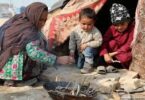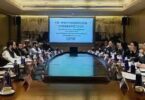WASHINGTON DC (The Soufan Center): Jihadist veterans from Central Asian maintain connections to Afghanistan, and there is a possibility that Central Asian fighters in the Levant will migrate to Afghanistan if the conditions are conducive.
Central Asian countries remain wary of the Taliban, given that it hosted or cooperated with the Islamic Movement of Uzbekistan (IMU), Jund al-Khilafah, and Turkistan Islamic Party (TIP) over the past two decades.
Any Taliban pledge to disallow terrorist groups from operating on Afghan soil should be met with skepticism, given the group’s traditional modus operandi.
If the Taliban is seen by other militants as becoming an “enemy” to longtime jihadist allies, it will allow Islamic State Khorasan to propagate narratives that the Taliban itself has abandoned jihad.
Within weeks of the Taliban’s conquest of Afghanistan in late August, the movement’s leadership indicated that it would not allow foreign jihadist groups, including from Central Asia, to operate on Afghan territory. The Taliban’s calculation is certainly aimed at assuaging the international community’s concerns. The Taliban seeks international recognition and legitimacy, which will require the group to prevent Afghanistan from once again becoming a terrorist haven, as it was in the years leading up to September 11, 2001. However, the Taliban also has more region-specific concerns for this policy position. The main Central Asian militant groups, such as the Uighur-led Turkistan Islamic Party, (TIP, formerly the East Turkestan Islamic Movement or ETIM), and al-Qaeda-aligned IMU offshoots, have relocated to Syria, with only a modest footprint in Afghanistan at present. However, many jihadist veterans of Central Asian origin in the Levant maintain connections to Afghanistan, and there is a possibility they will migrate to Afghanistan if the conditions are conducive for such a move or possibly if reports of violence against Afghan minority communities compel them to intervene.
Tajikistan initially indicated it would not only refuse to recognize the Taliban, but its leading religious authorities also condemned the Taliban’s approach to Islam as “oppressive.” Further, when the anti-Taliban resistance led by Amrullah Saleh and Ahmad Massoud appeared set to oppose the Taliban in Panjshir, a mountainous province north of Kabul, Tajikistan was reportedly offering the two leaders sanctuary in case they fled Afghanistan. This meant Tajikistan would become a long-term thorn in the Taliban’s side and possible lifeline to pro-democracy and anti-Taliban rebels. Ultimately, however, the anti-Taliban resistance weakened and Saleh’s whereabouts have remained unknown (his brother and spokesman, meanwhile, were killed by the Taliban in Panjshir).
Other Central Asian countries remain wary of the Taliban, given that it hosted or cooperated with the Uzbek-led Islamic Movement of Uzbekistan (IMU), Kazakh-led Jund al-Khilafah, TIP, and other Central Asian militant groups over the past two and a half decades. China, moreover, is Pakistan’s closest ally and both countries have pressured the Taliban to crack down on Central Asian militant groups. As a result, if the Taliban seeks to receive desperately needed international humanitarian aid and some level of regional, if not also international legitimacy, it has to promise to eliminate Central Asian militants on its territory. Though with similar Taliban pledges, including on the protection of human rights, women’s education and inclusive government, many remain highly skeptical of both the capability and willingness to deal with groups the Taliban has longstanding relationships with. This does mean the Taliban will not be forthcoming or should be trusted. After all, while the Taliban was engaged in the Doha peace talks with the U.S. that later led to the agreement on the U.S. withdrawal from Afghanistan, the Taliban hosted Al-Qaeda in the Indian Subcontinent (AQIS) leader, Asim Umar, on its territory (Umar was killed in a U.S. raid). This means the Taliban knowingly violated its commitment to not allowing al-Qaeda or international terrorists on its territory.
The Taliban cannot fully crack down on al-Qaeda or other Central Asian militants in Afghanistan without avoiding backlash from them and being perceived as betraying long-time allies whom they had initially offered protection. The truth is, the Taliban needs al-Qaeda and related jihadist groups, especially as the Islamic State Khorasan (ISK) continues to wage a low-level insurgency against the Taliban. Therefore, the Taliban will need to engage in some form of accommodation with those militants, such as not expelling them, but working to ensure they remain quiet, such as disallowing them from releasing videos or engaging in activities that come under the scrutiny of intelligence agencies and can expose the Taliban for failing to live up to its commitments. If the Taliban is seen by other jihadists as becoming too much of an “enemy” to longtime allies, it will also allow ISK to propagate narratives that the Taliban itself has abandoned jihad. Between placating the international community and neighboring countries and restricting, but not excessively alienating, local jihadist counterparts, the Taliban finds itself. In the midst of a delicate balancing game. While the Taliban has succeeded in taking over Afghanistan military, its diplomacy with foreign countries and local jihadist allies is evolving, and regional and international actors are still grappling with developing responses, especially in the wake of reports of continued Taliban suppression of women’s rights and violence against minorities. Time will tell whether the Taliban can be perceived as remaining faithful to the jihadist cause while also living up to international commitments with countries in Central Asia, as well as China and Pakistan and further abroad.






